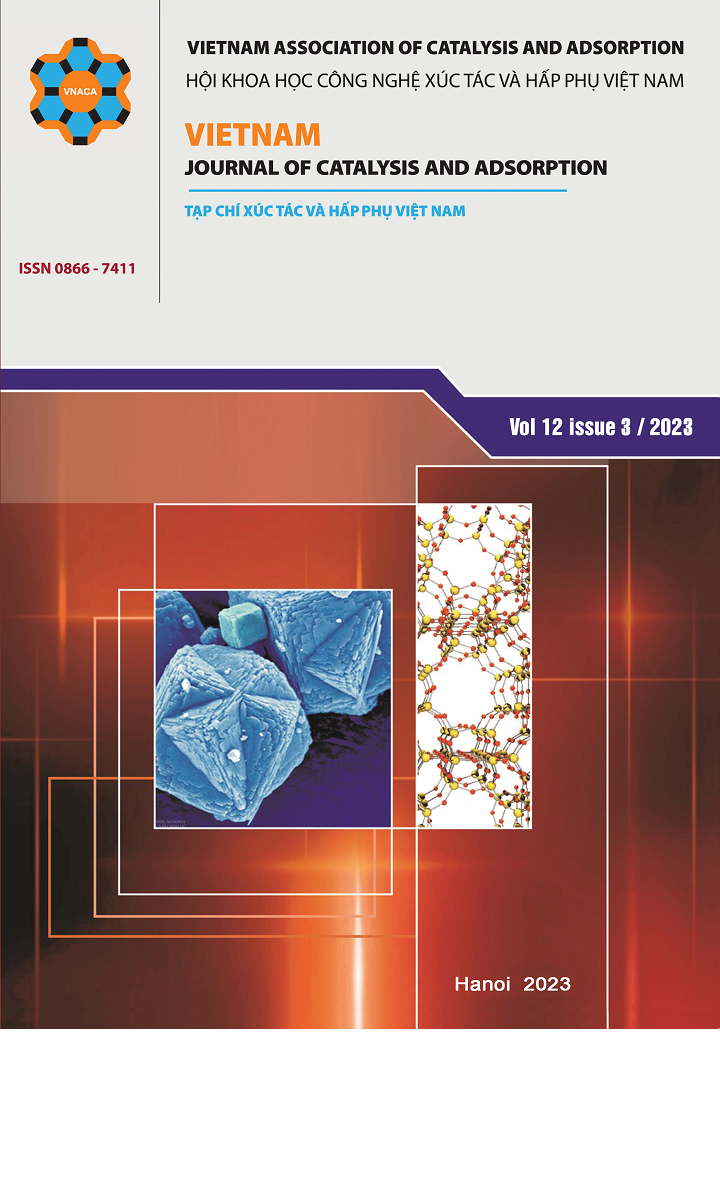Synthesis of Pt-Au nanoparticles supported on reduced graphene oxide as a highly active and durability catalyst for electro-oxidation of ethanol
DOI:
https://doi.org/10.51316/jca.2023.054Keywords:
Au-Pt/rGO, Durability improvement Graphene, Electro-oxidation CatalystsAbstract
Design of advanced electrocatalyst, with high active and stability in electro-oxidation reactions for Direct Alcohol Fuel Cells system is urgent scientific need in the context of electrochemical energy application. Herein, Pt-Au nanoparticles supported on reduced graphene oxide, with low content of metals (With the theoretical content of 1.87% (Au) and 4.67% (Pt)), as a highly active and durability catalyst for electro-oxidation of ethanol is successfully synthesized. The current density (mass specific activity) of the PtAu/rGO catalyst for electro-oxidation ethanol, in alkaline media, was 13195 mA mgPt-1, which is 1.26 times higher than that of the Pt/rGO catalyst. After 4000s, the current density of PtAu/rGO catalyst reached 317 mA mgPt-1, is higher than that of Pt/rGO catalyst, reaching 172 mA mgPt-1. The high catalytic activity and stability of the bimetallic PtAu/rGO catalyst in the electrochemical oxidation of ethanol in alkaline medium are attributed to the synergistic effect of Au, Pt and rGO, among which, Au not only plays the role of enhancing the dispersion of Pt, but also has the effect of preventing the agglomeration of Pt nanoparticles during the reaction. This research could open up the potential to develop advanced bimetallic PtAu materials that can be used as electrochemical catalysts for various reactions.
Downloads
References
Ahmed A.A., Al Labadidi M., Hamada A.T., Orhan M.F., Membranes, 12 (2022) 1266. https://doi.org/10.3390/membranes12121266
Chang J., Wang G., Wang M. et al., Nat Energy 6 (2021) 1144–1153. https://doi.org/10.1038/s41560-021-00940-4
Roschger M., Wolf S., Mayer K., Singer M., Hacker V., Energies 15 (2022) 7234. https://doi.org/10.3390/en15197234
Chandra Sekhar Yellatur et al, Nanotechnology 33 (2022) 335401. https://doi.org/10.1088/1361-6528/ac6df7
Thu Ha Thi Vu, Thao Thi Nguyen, Tien Hoang Nguyen, Minh Dang Nguyen, Quang Minh Nguyen, Electrochimica Acta 380 (2021) 138258. https://doi.org/10.1016/j.electacta.2021.138258
Wu W, Tang Z, Wang K, Liu Z, Li L, Chen S. P, Electrochimica Acta 260 (2018) 168-76. https://doi.org/10.1016/j.electacta.2017.11.057
Rakoˇcevi´c, L.; Simatovi´c, I.S.; Maksi´c, A.; Raji´c, V.; Štrbac, S.; Sreji´c, I., Catalysts 12 (2022) 43. https://doi.org/10.3390/catal12010043
M. Beltrán-Gastélum, M.I. Salazar Gastelum, J.R. Flores Hernandez, G.G. Botte, S.P. Sicairos, T. Romero Castañon, E. Reynoso Soto, R.M. Félix-Navarro, Energy, 181 (2019) 1225-1234. https://doi.org/10.1016/j.energy.2019.06.033
Vitale A, Murad H, Abdelhafiz A, Buntin P, Alamgir FM., ACS Appl Mater Interfaces 11 (1) (2019) 1026-32. https://doi.org/10.1021/acsami.8b17274
Gatalo M, Javanovi P, Polymeros G, Grote JP, Ruiz-Zepeda F, Selih VS, Sala M, Hocevar
S, Bele M, Mayrhofer KJJ, Hodnik N, Gaberscek M., ACS Catal, 6 (2016) 1630-4. https://doi.org/10.1021/acscatal.5b02883
Jang HD, Kim SK, Chang H, Choi J-H, Cho B-G, Jo EH, Choi J-W, Huang J., Carbon 2015; 93:869-77. https://doi.org/10.1016/j.carbon.2015.06.009
Vilian ATE, Hwang S-K, Kwak CH, Oh SY, Kim C-Y, Lee G-W, Lee JB, Huh YS, Han Y-K., Synthetic Metals 219 (2016) 52-9. https://doi.org/10.1016/j.synthmet.2016.04.013
W.S.Hummers, R.E. Offeman, Journal of the American Chemical Society 80 (1958) 1339. https://doi.org/10.1021/ja01539a017
Mahapatra, S. S., & Datta, J., International Journal of Electrochemistry, 2011, 1–16. https://doi.org/10.4061/2011/563495
C. Jin, J. Zhu, R. Dong, and Q. Huo, Electrochim. Acta, 190 (2016) 829–834. https://doi.org/10.1016/j.electacta.2015.12.222
J. K. Lee, J. Lee, J. Han, T. H. Lim, Y. E. Sung, and Y. Tak, Electrochim. Acta, 53 (9) (2008) 3474–3478. https://doi.org/10.1016/j.electacta.2007.12.031
S. Mourdikoudis et al., Nanoscale, vol. 7, no. 19, pp. 8739–8747, 2015. https://doi.org/10.1039/C4NR07481E
Y. Wang, S. Zou, and W. Bin Cai, Catal. 5 (2015) 1507-1534. https://doi.org/10.3390/catal5031507
A. S. Pushkarev et al., Catal. 9 (3) (2019) 271. https://doi.org/10.3390/catal9030271.
G. Yang, Q. Zhang, H. Yu, and F. Peng, Particuology, 58 (2021) 169–186. https://doi.org/10.1016/j.partic.2021.01.007






